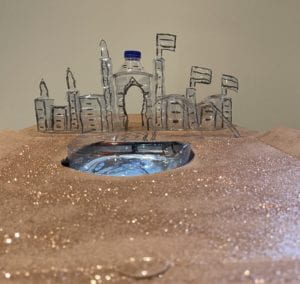
Plastic Paradise?!
by Mohammed Arham and Pangna Sun, 2021
Mainly made out of plastic bottles, the installation is an allegory of Atlantis, The Palm in Dubai, UAE. The aim is to show the plastic footprint left behind by our daily plastic consumption and waste. According to the Natural Resource Defense Council(NRDC), “we produce 300 million tons of plastic each year worldwide, half of which is for single-use items.” The UAE alone uses 11 billion plastic bags and 450 plastic bottles annually. Thus, this plastic model of Atlantis, The Palm symbolizes the plastic footprint in the UAE and the rest of the world and makes people realize the false notion of paradise created by plastic. We chose Atlantis, The Palm with the hope that its international recognition will spread this message to all people across the globe.
More about our project:
This project was quite a journey for us. We started with researching and brainstorming ideas of how to make people aware of plastic and trash problem as well as to find creative uses of trash. We came to a realization that most of daily products and waste are plastics. Thus, we decided to create a model of plastic to symbolize the plastic footprint left behind by our daily consumption of plastic products. Then, we did more research to figure out which famous buildings to base our model on. At the end, we chose Atlantis, The Palm in Dubai, UAE, hoping that its worldwide recognition will allow our message to reach as many people as possible. Thus, our project is an installation of a plastic model of Atlantis, The Palm, which allegorizes the plastic footprint left behind by our daily consumption and waste.
Building the model of Atlantis, The Palm was not smooth sailing. Our limited tools, two pairs of scissors and a cutter knife, made it hard for us to cut the plastic bottles precisely. The obtained cut parts did not have straight edges, making it challenging to tape these parts perfectly. As a result, the model was fragile and unstable. We needed to use a lot of tapes to make them stick well together.
We hope to further improve installation by adding more types of trash to show that plastic waste is not the only problem. Pieces of fabric could be used to indicate the issue of fast fashion, which overproduces clothes every day and leaves behind an extraneous amount of waste. In addition, with a wider variety of trash materials, we could create more models of famous monuments from around the world to cover the global range that we try to send our message across.
Leave a Reply